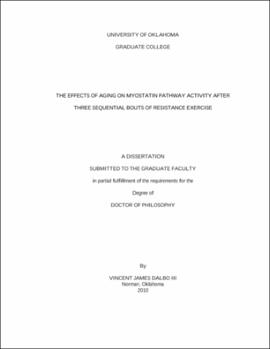| dc.contributor.advisor | Kerksick, Chad | |
| dc.creator | Dalbo, Vincent James | |
| dc.date.accessioned | 2019-04-27T21:38:47Z | |
| dc.date.available | 2019-04-27T21:38:47Z | |
| dc.date.issued | 2010 | |
| dc.identifier | 9949517602042 | |
| dc.identifier.uri | https://hdl.handle.net/11244/319245 | |
| dc.description.abstract | Background. Myostatin signaling serves to regulate skeletal muscle mass by influencing genes responsible for regulating satellite cell activity and by participating in glucocorticoid induced skeletal muscle atrophy; however research investigating myostatin pathway signaling is still in its infancy. | |
| dc.description.abstract | Purpose. The purpose of this investigation was two-fold: 1) To examine if baseline differences in myostatin signaling exist between younger (18-35 yr) and older (65-80 yr) men. 2) To examine if short-term, chronic resistance training can ameliorate potential differences in myostatin signaling that exist between younger and older adults. | |
| dc.description.abstract | Methods. Younger (n = 10; age: 21.0 ± 0.5 years, body mass: 82.3 ± 4.2 kg, height: 178.4 ± 2.2 cm, body fat percentage: 15.4 ± 2.9%) and older (n = 10; age: 66.4 ± 1.6 years, body mass: 94.2 ± 3.7 kg, height: 180.9 ± 2.2 cm, body fat percentage: 27.4 ± 1.8%) men chose to participate in the current investigation. Participants were one repetition maximum tested (1 RM) for leg press, hack squat and leg extension. Then participants underwent two familiarization sessions separated by 48 hours before partaking in three training sessions separated by 48 hours which consisted of 3 sets of 10 repetitions at 80% of 1RM for each of the previously mentioned exercises. Percutaneous muscle biopsies were collected from the vastus lateralis prior to the exercise intervention (T1), 48 hours following workout 1 (T2), 48 hours following workout 2 (T3), and 24 hours following workout 3 (T4). The mRNA expression of MYOSTATIN, ACTIVIN IIB, HSGT, TITIN CAP, FLRG, FOLLISTATIN and SMURF1 were analyzed in duplicate and expressed using the 2-∆CT method where ∆CT = (gene of interest - the average of B2M and 28S). The protein expression of phosphorylated Smad3 (pSmad3) was determined using western blotting procedures. | |
| dc.description.abstract | Results. Younger men had a significantly greater 1 RM for hack squat (younger: 170.0 ± 10.9 kg, older: 105.8 ± 10.4 kg; p = 0.001), leg press (younger: 271.1 ± 14.6 kg, older: 182.7 ± 14.9 kg; p < 0.001) and leg extension (younger: 64.8 ± 4.0 kg, older: 46.7 ± 2.8 kg; p = 0.002) compared to older men. As a result the cumulative training volume was significantly greater during the training bouts in younger compared to older men (younger: 36,392 ± 1,894 kg, older: 23,724 ± 1,639 kg; p < 0.001). Three day food diaries indicated that relative caloric (young = 33.4 ± 5.1 kcal/kg/d, old = 19.5 ± 1.9 kcal/kg/d; p = 0.038), protein (young = 1.6 ± 0.2 g/kg/d, old = 0.8 ± 0.1 g/kg/d; p = 0.030), carbohydrate (young = 4.1 ± 0.6 g/kg/d, old = 2.3 ± 0.3 g/kg/d; p = 0.017) and fat (young = 1.2 ± 0.2 g/kg/d, old = 0.6 ± 0.1 g/kg/d; p = 0.006) consumption were each significantly greater in younger compared to older men. Non-parametric statistics were used for the assessment of mRNA and protein data. The only between groups differences for the mRNA expression of the genes of interest occurred at baseline (p = 0.038) and T4 (p = 0.005) for FLRG and baseline (p = 0.023) and T2 (p = 0.008) for FOLLISTATIN in which older men had significantly greater mRNA expression values compared to younger men. The only significant within group changes occurred in the mRNA expression of MYOSTATIN as older men had a significant downregulation following T3 (p = 0.047) and T4 (p = 0.013), while younger men experienced a trend decrease following T4 (p = 0.074). Significant between group differences were present in the protein expression of pSmad3 following T3 (p = 0.012) and T4 (p = 0.010). | |
| dc.description.abstract | Conclusions. Baseline differences in myostatin signaling were present as older men had significantly greater mRNA levels of the myostatin binding proteins FLRG and FOLLISTATIN compared to younger men. The myostatin pathway signaling response following short-term, chronic resistance training was similar between younger and older men. However, alterations in myostatin pathway signaling following repeated resistance training bouts was more favorable in older men. Specifically, older men experienced a significant decrease in the mRNA expression of MYOSTATIN at T3 and T4. Older men also had significantly lower pSmad protein levels at T3 and T4 compared to younger men. Decrements in serum androgen concentrations appear to be primarily responsible for the loss of skeletal muscle mass with age. However, in attempt to maintain skeletal muscle mass with age positive physiological adaptations have been found to occur such as an increase in the mRNA expression of ANDROGEN RECEPTOR and myogenic regulatory factors. Results from the current investigation provide evidence that favorable adaptations occur in myostatin pathway signaling to promote skeletal muscle growth with age and following short-term, chronic resistance training. | |
| dc.format.extent | 120 pages | |
| dc.format.medium | application.pdf | |
| dc.language | en_US | |
| dc.relation.requires | Adobe Acrobat Reader | |
| dc.subject | Transforming growth factors-beta | |
| dc.subject | Aging--Physiological aspects | |
| dc.subject | Exercise--Physiological aspects | |
| dc.subject | Muscles--Aging | |
| dc.title | THE EFFECTS OF AGING ON MYOSTATIN PATHWAY ACTIVITY AFTER THREE SEQUENTIAL BOUTS OF RESISTANCE EXERCISE | |
| dc.type | text | |
| dc.type | document | |
| dc.thesis.degree | Ph.D. | |
| ou.group | College of Arts and Sciences::Department of Health and Exercise Science | |
